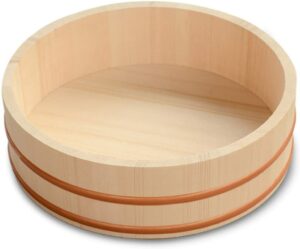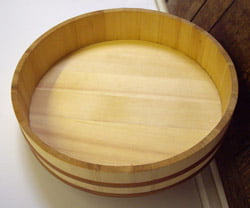Wooden rice bowl (or Hangiri)
A hangiri (also known as a sushi oke) is a wonderful cooking device: it’s a Japanese wooden tub that’s used in the final steps of preparing sushi rice.
While that might be a fairly humble description (a tub that’s used to make rice), the hangiri is actually very well designed for the job that it does. It’s typically very wide and flat, which means that you can cool the hot rice very quickly after pouring in seasoning – the mixing process with a traditional rice paddle also helps with this cooling phase.
The final bonus feature of using a hangiri is the fact that the mixing process (within a hangiri) helps to give the rice a shiny appearance, while also speeding up the final phase of evaporation and absorption. The speeding up of those two things means that the final phase of cooking the rice is quicker, so the rice itself doesn’t get mushy, as overcooked rice would.
A good quality hangiri is made from cypress or cedar wood and is bound similarly to a barrel – with two copper bands. These material choices can make hangiri quite expensive indeed: at least $75.
If you’re buying one that’s cheaper than that, then it is typically knock-off, made outside of Japan. For example, it may be made from pine and plastic instead. This change in materials would mean that the hangiri itself will need to be replaced fairly quickly – within a year or two.
By contrast, a well-made hangiri can last a lifetime if it is well maintained.

The history of hangiri
Well, this is actually a bit of a tale that’s hard to nail down.
The earliest records of sushi out there in the world are in rice paddies in ancient southern China. These sushi dishes were made through the fermentation of fish, with the carbohydrates within the rice being used as ‘fuel’ for the bacteria to do their work. This method of preparation meant that the rice wasn’t eaten, and so didn’t need to be cooked.
However, from the eleventh century and onward, rice stopped being prepared in this way, and generally started to be steamed or boiled instead – this meant that it was eaten along with the fish.
It’s hard to say when the combination of cold fish and hot rice may have occurred, but it’s unlikely to have been a happy one. With the advent of refrigeration, people were able to keep fish colder for longer. This would have exacerbated the problem, leading to a solution needing to be found.
Necessity is, of course, the mother of invention, and over time various different methods resulted in the hangiri – the ideal tool for finishing the cooking process of rice and making sure that it is dry and cool. From there, making sushi that we would consider to be modern became much simpler!
The practical use of this tool today?
Since the world is becoming more and more automated, leading to a wealth of machines being able to do a wealth of jobs, you might wonder why sushi chefs still use hangiri. Well, it’s quite simple: it’s just the best tool for the job.
First of all, the wood itself is uncoated, meaning that it’s ideal for absorbing the final dregs of water from the rice. This, in turn, stops the rice from drying out, too – a perfect balance!
Also, the uncoated wood has a gentle scent, similar to pine or other light wood. This smell goes very well with the rice as the cooking process is ongoing, and doesn’t interfere with the aroma of the sushi rice itself, thankfully.
Finally, the antibacterial nature of the cypress wood and the copper bands mean that you can have peace of mind with regards to hygiene, whereas a machine would need much more cleaning and maintenance.



Looks really nice. I’m into full time sushi making now, I will consider getting one from Amazon ASAP.
When I look at Amazon, I see a bunch of hangiri in the $25-$50 range made from bamboo, and hangiri made from Cypress that are more expensive. What impact does the wood in the hangiri make in the process of making sushi, if any?